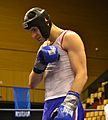Savate facts for kids
| Also known as | French footfighting, French boxing, French kickboxing |
|---|---|
| Focus | Striking |
| Hardness | Full contact |
| Country of origin | |
| Creator | Michel Casseux |
| Famous practitioners | Michel Casseux, Joseph Charlemont, Pierre Baruzy, Gerard Gordeau, Gioachino Rossini, Lord Byron, Charles Lecour, Bruce Lee, Alexandre Dumas, Richard Sylla, Gilles Le Duigou, Amri Madani, Fred Royers, Pierre Vigny |
| Parenthood | Boxing, Ancient footfighting |
| Olympic sport | only the 1924 Summer Olympics |
Savate is a French martial art. It is also called boxe française (French boxing) or French kickboxing. In Savate, people use their hands and feet to strike their opponents. It combines moves from Western boxing, some grappling techniques, and special leg moves. Only the feet are used for kicks, not knees or shins. People who practice Savate are called savateurs (for men) or savateuses (for women). Sometimes, they are also called "tireurs".
Contents
History of Savate
Savate gets its name from an old French word for "old shoe." This is because heavy shoes were used during fights long ago. Savate today is a mix of French fighting styles from the early 1800s.
Back then, Savate was a common fighting style in Paris and northern France. In the south, especially in the port of Marseille, sailors had their own style. It was called jeu marseillais ("the game of Marseilles"). Later, it got a new name: chausson ("slipper"). This name came from the light shoes sailors wore. At the same time, in England, people thought kicking was unfair in sports. They saw it as something only cowards did.
How Savate Became a Sport
Two important people helped turn street fighting into modern Savate. They were Michel Casseux (1794–1869) and Charles Lecour (1808–1894). In 1825, Casseux opened the first place to teach a rule-based version of chausson and Savate. He banned dangerous moves like headbutts or eye pokes.
However, it was still seen as a street fight. Charles Lecour was a student of Casseux. In 1830, he learned about English boxing. He realized that in Savate, he was using his hands to hit the opponent's feet. This was different from punching in boxing. So, he trained in boxing for two years. In 1832, he combined boxing with chausson and Savate. This created the sport of savate boxe française we know today.
Savate at the Olympics
Savate gained a lot of respect in 1924. It was shown as an exhibition sport at the 1924 Summer Olympics in Paris. Even though it started as street fighting, Savate is a fairly safe sport to learn. Compared to sports like soccer, football, hockey, gymnastics, basketball, baseball, and speed skating, Savate has fewer injuries.
Famous Savate Practitioners
Many people have practiced Savate. Some famous names include Gioacchino Rossini, Lord Byron, and Alexandre Dumas. Other important figures are Michel Casseux and Charles Lecour, who helped create the sport. Modern fighters like Richard Sylla and Amri Madani are also well-known.
Savate Today
Today, people all over the world practice Savate. You can find it from Australia to the United States, and from Finland to the United Kingdom. Many countries, like the United States, have national groups. These groups work hard to help the sport grow.
Competition Levels
Modern Savate has three main levels of competition:
- Assault: In this level, fighters focus on good technique. They try to make contact, but referees punish them for using too much force.
- Precombat: This level allows more force. Fighters must wear protective gear like helmets and shin guards.
- Combat: This is the most intense level. It is like precombat, but protective gear is not allowed. Only groin protectors and mouthguards are used.
Glove Colors and Levels
Many martial arts use different colored belts to show a person's skill level, like in karate. Savate uses different colored gloves for the same reason. However, unlike judo or capoeira, a fighter can use the same pair of gloves for several promotions. This means the glove color you wear might not directly match your current skill level. Your official level is recorded on your license.
Beginners start without a color. As they pass exams, they can move up through different levels. The order of glove colors is: blue, green, red, white, and yellow.
Only fighters with red gloves or higher can compete. Each national group can set its own rules for teaching Savate. In France, you need a yellow glove to become an instructor (moniteur). To become a teacher (professeur), you need a silver glove in your technical category. In other countries, like Mexico, green glove levels and higher require an evaluation. This ensures they can help teach and grow the art.
Images for kids
See also
 In Spanish: Savate para niños
In Spanish: Savate para niños






